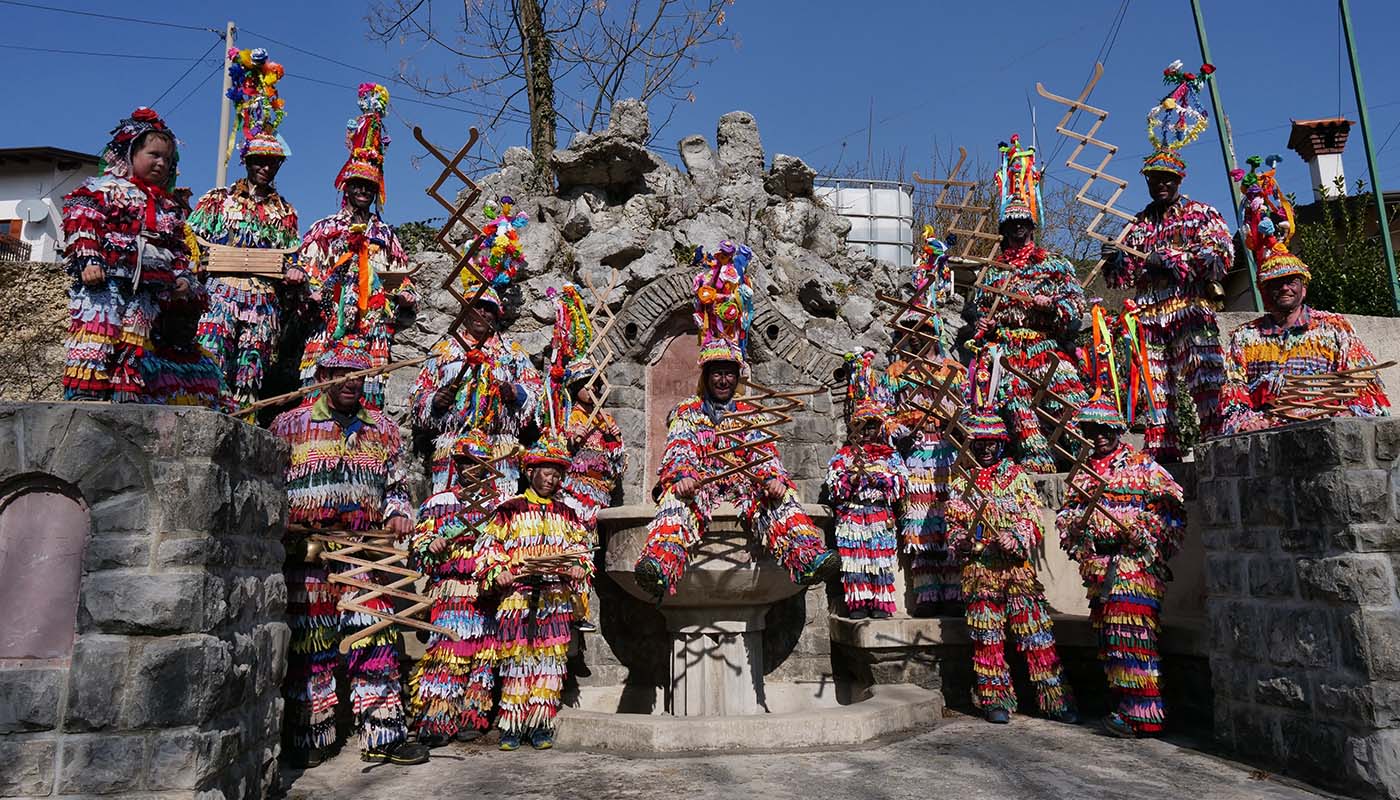
ANCIENT SLOVENIAN CARNIVAL TRADITIONS ALONG THE SOČA RIVER
by SARA TERPIN
Carnival is a popular festival among Slovenians and, especially in places that are a little more isolated or linked to rural life, it still retains tangible traces of an ancient past, made up of rituals and symbols that not even Christianity has been able to erase.
In small villages far from the cities and emptied by depopulation, carnival is a long-awaited moment in which the community comes back to life, people gather, bringing music and colors among the half-empty houses.
Thus, in the small villages around Lig, an ancient tradition is revived every year during the carnival period: that of the “Liški pustje”. The importance of this traditional festival and the handcrafted masks that are its protagonists was sealed in 2020 by the Slovenian Ministry of Culture, which included Liški pustje in the National Register of Intangible Cultural Heritage.
It is an ancient custom that, after the First World War, was abandoned and was in danger of extinction without a trace. It was saved from oblivion by the writer, painter and ethnography enthusiast Pavel Medvešček, who together with Branko Žnidarčič, a skilled craftsman from Kanal, reconstructed the ancient masks. These are very special in the panorama of traditional Slovenian masks, usually carved in wood: those of the Liški pustje, in fact, are made of sheet metal (once copper, today aluminum).
The Liški pustje group is very varied and made up of many characters, each with their own role. Like other traditional Slovenian masks, Liški pustje are divided into two subgroups: “Ta grdi” (“the ugly”) and “Ta lepi” (“the beautiful”). Only the “beautiful” (represented by a married couple, a doctor and a guard) have the privilege of being able to enter the houses, where they perform an auspicious dance to the sound of the accordion.
But the masks whose origin is oldest are those of the “ugly”: in fact, in them, we find typical elements that also characterize masks from other Slovenian regions and, in a broader framework, from all of Central Europe. Their costume is made of sheepskin or other natural materials, such as the husking of lime bark (a tree considered sacred). On their heads they have horns or tree branches and in their hands wooden sticks or stockings full of ashes with which they hit boys and girls.
The Pustje are also part of the group of the “ugly”, also characterized by elements that are found in other traditional Slovenian masks: the colorful ribbons that make up the costume, the cowbells tied at the waist and the sheepskin headdress with applied horns. The Pustje go around the villages “armed” with long pincers with which they enjoy capturing girls and children.
Pincers and costumes made of colorful fabric ribbons are also characteristic of the Pustarji, traditional masks of the villages around Grgarske Ravne and Bate, between Sveta Gora and the Banjšice plateau.
The Pustarji are distinguished by a particular headdress, a true symbol of the group, formed by four arches and a bell at the top. They run around the village to announce the end of winter and the arrival of spring, but they also take the opportunity to play pranks and catch girls and children with their long pincers. The group also includes the Klobasonar (literally “the sausage man”), who with his helper goes around house to house, accompanied by songs and dances, to collect gifts, mostly eggs, sausages and other foodstuffs. These gifts will then be used to prepare the group dinner at the end of the day.
The “sausage man” or “poberin”, the one who collects the gifts, is an essential figure of every traditional masked group. With the name of Klabason we also find it among the typical masks of Kal nad Kanalom, a tradition abandoned in the 50s of the last century and recently revived thanks to the efforts of the local folk group. Also in this case, the research of Pavel Medvešček and the advice of the craftsmen Branko Žnidarčič and Franc Jerončič were of fundamental importance for the reconstruction of the masks. To prepare the sketches for the costumes based on these studies was the designer Elza Pavšič, who also made the papier-mâché masks by hand according to a traditional method.
The Kal nad Kanalom group of masks is made up of various characters representing social classes (peasants, city dwellers, doctors, beggars…), but also older figures with symbolic meaning, such as the married couple (symbol of fertility) and the Cundrin, whose appearance resembles that of a ghost and who represents the spirit of the ancestors. Leading the procession are Pust and Pustovka, also known as “ta stari” (the old men) or “ta grdi” (the ugly). Both are frightening, especially Pust with his costume made of skins, the mask with horns, the cowbells around his waist and the stocking full of ashes hanging from a stick. Very particular is the mask called “Pu ‘n pu” (“half and a half”) or “Ne tič ne miš” (“neither bird nor mouse”), half man and half woman, with two heads carved in wood, while the wearer hides his face under a sieve.
After the raids of the carnival days, in all Slovenian traditions Ash Wednesday is dedicated to the “carnival trial”, a sort of scapegoat who is found guilty of all evils and who as such will be executed at the stake, only to be “reborn” a year later and bring back to life the jokes of the carnival upside-down world, but also the ancient propitiatory rites that are hidden under the cheerful surface of this beloved tradition.
